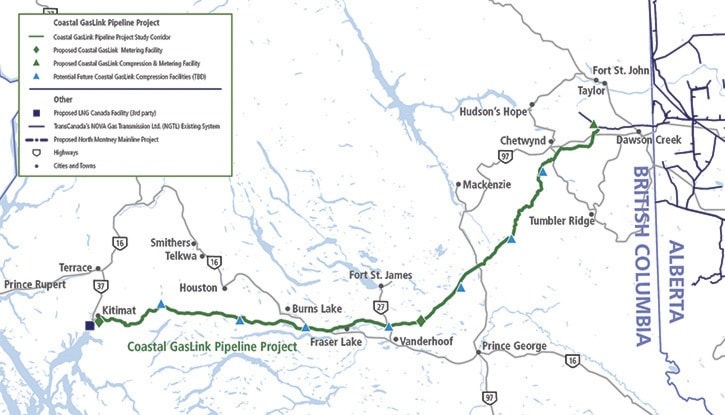Coastal GasLink Pipeline Ltd. (Coastal GasLink) is considering the feasibility of an alternate route to its proposed pipeline that would run mostly north of the Morice River.
Coastal GasLink, a wholly-owned subsidiary of TransCanada Pipelines Ltd., proposes to develop a natural gas pipeline from near Dawson Creek, B.C., to the proposed LNG Canada liquefied natural gas export facility near Kitimat, B.C.
The proposed alternate pipeline route would be about five kilometers north of the current route. While the initial route would mostly run south of the Morice River, most of the alternate route is on the north side of the river, beginning approximately 35 km south of Houston.
According to Coastal GasLink, the decision to move the route follows extensive consultation with Aboriginal groups who were concerned about the potential effect to the underground springs that feed the Morice River.
Shela Shapiro, Coastal GasLink Spokesperson, said the alternate route north of the river would provide an option that addresses the potential effect to the underground springs. In addition, she says the new route would run through an area that has already been disturbed through logging activity.
The proposed alternate route would also be further away from the Unist’ot’en camp. While the initial route would run about one km south of the Unist’ot’en camp, the alternate route would be approximately five km north of the camp.
The Unist’ot’en clan of the Wet’suwet’en has set up a protective camp south of Houston and has been physically impeding pipeline proponents such as TransCanada and Chevron from entering their territory.
Although both the initial and the alternate route do not cross the Unist’ot’en camp directly, Shapiro says Coastal GasLink would still need to conduct fieldwork on Unist’ot’en territory next year.
“The plan next year would be the same as this year - our crews would be accompanied by local Wet’suwet’en and others to help us ensure their cultural and historical resources are identified, respected and protected,” said Shapiro. “We continue to pursue a resolution with representatives of Dark House [Unist’ot’en] and our preference is to engage with them in a meaningful fashion in an effort to achieve consensus.”
Coastal GasLink anticipates filing an application to amend its environment assessment certificate for the new route as early as November 2015, and applying to the B.C. Oil Gas Commission for approval of the new route shortly after.
“The final route will be determined as an outcome of these regulatory processes, and once we have had the opportunity to advance construction planning and detailed engineering design taking into account cultural, environmental, commercial, and constructability considerations,” explained Shapiro.
According to Coastal GasLink, Aboriginal groups whose traditional territory may be potentially impacted by the proposed alternate route were invited to participate in “field data collection programs and provide traditional ecological knowledge.” Coastal GasLink says the company has had over 9200 engagements with Aboriginal communities along the proposed routes.
